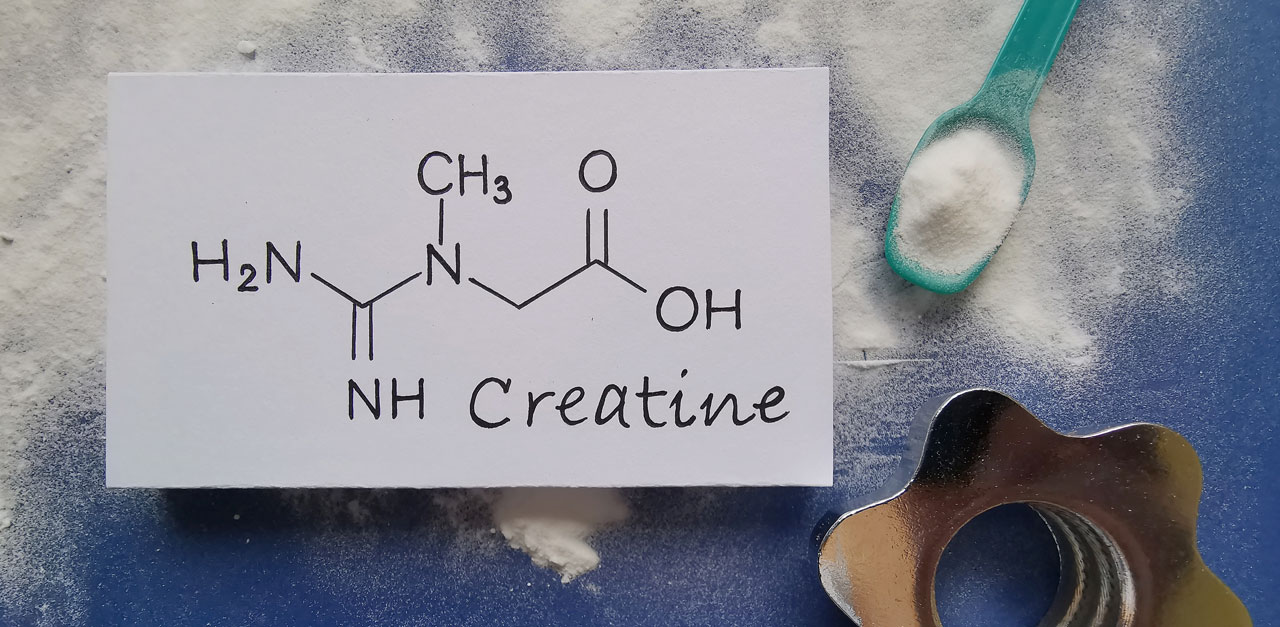
Construction and occurrence
Creatine (Cr) is a small peptide made of amino acids. It naturally occurs mainly in red meat and seafood. Most of it is found in skeletal muscle (about 95%), while it remains in the brain and testicles. The total amount of creatine stored in the muscles is about 120 mmol / kg dry muscle mass (for a person weighing 70 kg). However, the upper limit of its resources can reach up to 160 mmol / kg. About 1-2% of intramuscular creatine is degraded and excreted in the urine. For this reason, the body requires it to be replenished daily (1-3 g / day). Almost half of the daily requirement is met through the diet. Creatine from food undergoes a slower digestion process than when taken externally. The remaining amount is mainly produced in the liver and in smaller amounts in the pancreas and kidneys. However, many people have a creatine deficiency due to disorders in the construction and functioning of Cr transporters.
How does creatine work?
Creatine was classified in category I (strong scientific evidence supporting effectiveness, relative safety) of supplements supporting the building of muscle mass, as well as supporting performance on the list created by the International Society of Sports Nutrition in 2018. In addition, the Australian Sport Institute in 2019 included creatine in group A, i.e. a group of ergogenic supplements with strong scientific evidence confirming the benefits of using it in specific sports situations. Creatine works by increasing the amount of ATP available, which is the most important energy molecule at the cellular level. Creatine supplementation increases its intramuscular resources, which particularly supports efficiency in high-intensity efforts. In addition, creatine has a positive effect on increasing regeneration and supports injury prevention. Research shows that supplementation increases muscle creatine availability, leading to increased exercise capacity and adaptation to training. The benefits of supplementation are observed among both men and women.
Creatine forms - which one to choose?

Creatine can be bought in many different forms, such as monohydrate, malate, and citrate. Creatine monohydrate has the most proven effects in scientific studies. Currently, there is no scientific evidence confirming that other forms are less degraded or result in greater creatine uptake by muscles. In addition, the monohydrate is characterized by the highest creatine content, good absorption and a relatively low price.
Creatine dosage

For a regular diet of 1-2 g Cr / day, 60-80% of the creatine content is saturated. Additional supplementation can increase its amount by 20-40%. There are two supplementation protocols described in the literature. The first of these assumes taking 5 g of creatine monohydrate per day (or about 0.3 g / kg body weight) 4 times a day for 5-7 days. When creatine reserves are saturated, we use a maintenance dose of 3-5 g / day. As a result of the creatine loading process, we can see a 20-30% increase in performance during intense efforts. An alternative supplementation protocol is taking 3 g creatine monohydrate daily for 28 days. In this method, however, we observe a gradual increase in creatine resources, compared to the fast loading method. Such action may cause a less noticeable effect in improving performance, until the saturation of Cr resources in the muscles. Both protocols are intended to saturate muscles with creatine, but the use of charging will allow you to reap potential benefits faster.
Is supplementation safe?
Based on approximately 1,000 studies conducted to date with creatine monohydrate, the only reported side effect of supplementation is weight gain. However, this is really a desirable effect. Creatine is 95% accumulated inside the muscles, which is associated with increased accumulation of glycogen and water. Lack of water retention may even suggest that too low a dose of creatine is being supplemented. However, it should be remembered that if initially the concentration of creatine is high, we may not notice any special effects after the implementation of supplementation. It is worth adding that people on a plant diet are characterized by its lower resources, which allows you to conclude that supplementation in this case will bring greater benefits.
Summary
Creatine monohydrate is the most effective ergogenic supplement. It should be used by people who want to increase their ability to perform high-intensity exercise, as well as support post-workout regeneration.
Bibliography:
- Kim HJ, Kim CK, Carpentier A, Poortmans JR. Studies on the safety of creatine supplementation. Amino Acids. 2011 May;40(5):1409-18.
- Kreider RB, Kalman DS, Antonio J i in. International Society of Sports Nutrition position stand: safety and efficacy of creatine supplementation in exercise, sport, and medicine. J Int Soc Sports Nutr. 2017 Jun 13;14:18
- Cooke M.B. et al., Creatine supplementation enhances muscle force recovery after eccentrically-induced muscle damage in healthy individuals, "J Int Soc Sports Nutr."





